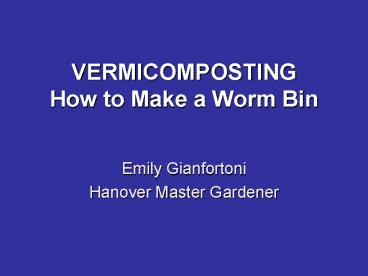VERMICOMPOSTING How to Make a Worm Bin - PowerPoint PPT Presentation
1 / 29
Title:
VERMICOMPOSTING How to Make a Worm Bin
Description:
Tea bags and coffee grounds. Egg shells (crushed) Pumpkins and watermelons ... Continue to remove compost from each pile until mostly worms remain ... – PowerPoint PPT presentation
Number of Views:731
Avg rating:3.0/5.0
Title: VERMICOMPOSTING How to Make a Worm Bin
1
VERMICOMPOSTINGHow to Make a Worm Bin
- Emily Gianfortoni
- Hanover Master Gardener
2
Why Have a Worm Bin?
- Recycles food wastes instead of sending to
landfill - Reduces load on sewage or septic systems
- Produces useful organic product for yard or
garden - Encourages respect for living things and natural
cycles
3
Why Have a Worm Bin in the Classroom?
- Can be used to teach science and environmental
stewardship - Can serve as a conduit of information about
recycling to homes of students - Will be a model for other classrooms and other
schools - Grant funds available for expanding beyond
plastic tubs for worm bins
4
Eisenia fetida Red WigglerDifferent from
Common Earthworm
5
Characteristics of Common Earthworm (Lumbricus
terrestris)
- Soil-dwelling tunnels and burrows
- Does not eat large amount of organic material
- Will not reproduce well while confined
- Lives several feet below surface
- Feeds on surface at night
- Requires cool (45º) temperature
6
Characteristics of the Red Wiggler
- Can eat half its weight of food per day
- Requires 70 moisture to breathe
- Ideal temperature 60º to 85º F
- Can thrive in confined space
- Needs good ventilation and drainage
- Needs bedding and food
- Avoids light
7
Worm and Cocoon
8
Constructing the Bin
9
Materials Needed
- Bin made of opaque, flexible plastic, approx. 18
x 20 x15 inches - Shredded newspaper
- Water
- Compost or soil
- Worms
- Drill with ¼ bit
10
Drill holes in top of bin and part way down sides
11
Dampen shredded paper Squeeze out excess water
12
Fill bin with 6 to 8 in. of moist bedding
13
Add compost
14
Place worms in bin
15
Choosing a Place for the Bin
- 59-77 degrees F optimal temperature
- Below 59º F feeding slows
- Can not tolerate temperature below 40º
- Will die if temperature hotter than 90º
- Basement or kitchen
- Garage if temperature above freezing
- Outside in shade in warm weather
16
Feeding Your Worms
- Bury food in small amount of bedding
- Or wrap in layer of newspaper and place on top of
bedding - 1 lb. per sq. foot per week
17
Things to Feed Your Worms
- Most vegetable and fruit wastes
- Bread and pasta
- Old food from the refrigerator (no meat)
- Tea bags and coffee grounds
- Egg shells (crushed)
- Pumpkins and watermelons ?
18
Things NOT to Feed Your Worms?
- Meat, fish or bones
- Very oily or greasy foods
- Too many citrus peels
- Dog or cat feces
- Raw onions (can produce odor)
- Plastic, foil or other non-organics
19
Harvesting Your VermicompostMethod One
- Move bedding and worms to one side
- Place fresh bedding and food on other side
- Leave bin for 2 weeks or more
- Harvest castings after worms have moved
20
Harvesting Your VermicompostMethod Two
- Dump contents of bin on sheet of plastic
- Divide into piles
- As worms burrow into piles, remove top layer
- Continue to remove compost from each pile until
mostly worms remain - Return worms to bin with fresh, moist bedding
21
Harvesting Your VermicompostMethod Three
- Remove 2/3 of vermicompost with worms and dump in
garden - Add fresh bedding and food to remainder in bin
- Enough worms and cocoons remain to repopulate bin
22
What are worm castings?What is vermicompost?
- Worm castings worm poop
- Worm castings contain beneficial bacteria,
enzymes, minerals and remnants of plant materials - Vermicompost worm castings humus
microorganisms partially decomposed bedding and
plant materials
23
Uses for Vermicompost
- Source of useful bacteria, fungi, nematodes,
enzymes and plant nutrients for soil - Use in potting soil (10 to 25)
- Sprinkle lightly in seed beds
- Place small amount in planting hole with
transplants - Use as top dressing in garden (1/4 in. layer)
24
Troubleshooting Problems Usually Minimal
- Bad odors
- Flies
- Bin too wet
- Bin too dry
- Worms crawling up sides
- Worms dying
25
Problem Bad Smell
- Bin too wet remove water with turkey baster add
dry bedding or peat moss - More food than worms can eat stop feeding for a
week or two - Not enough air add more air holes fluff bedding
- Food on top smells bury under bedding
26
Problem Flies
- Fruit flies most common, but also house flies
- Keep bin covered and bury food in bin
- Add food as soon as available or freeze
- Dont overfeed worms
- Dont add food wastes that have already attracted
fruit flies (e.g. banana peels)
27
Problem Bedding Too Wet or Too Dry
- Too dry add water or watery food such as
watermelon - Too dry keep covered lay a sheet of black
plastic on top of bedding - Too wet give food lower in water
- Too wet add dry bedding or peat to bottom
- Too wet drain off water in bottom of bin
28
Problem Worms Crawling Out or Worms Dying
- Worms on sides put bin in light area with top
off (worms avoid light) - Worms on sides try not to disturb bin and
bedding - Worms dying (fishy smell) make sure worms have
enough food, air and correct moisture level
29
Playing with Worms Is Fun!






























